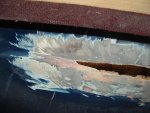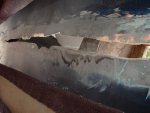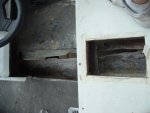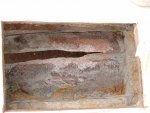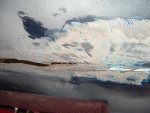Re: Failed hull repair...need advice/1981 Ranger 320-V Commanche
Not really, the process itself hasn't changed, just the size of the repair. To gain access to the area under the aft seat and the forward step an easy way to do this and cover it back up when finished is to use a couple of large plastic deck plates. Most are round but they also make rectangle shaped ones. Essentially it's a flat white frame that gets screwed to the deck / surface and has a removable lid. This will save alot of glass and gel work for covering up the access areas. Just make sure to know what the cut out size for the plates is before diving in.
I would do what I outlined above to the exterior side start to finish. Then when that has cured you will now have a solid surface / backer for doing the inside grinding and repairs. It's the same process, just different working conditions. On the inside areas I would make sure to get a couple layers of 1708 in there for added strength. Layups should go as follows:
- 1.5oz csm
- 1708 (if the crack is on a chine, the 1708 will not take a sharp curve / bend.) try taking 2 pieces and laying them into the crack to form a V (one piece on each side of the split edges butting together to form the V. When that has cured take some of Oops filler and somewhat fill in this crack giving you more of a rounded fillet rather than a hard angle. Then lay glass on top of that bridging the whole works.
- cms, 1708 and 1 more csm.
The surface that you're glassing onto has to be clean and dry otherwise the resin won't cure or bond. Scuff everything up with 60 grit and clean with acetone. Dont be shy with the paper towel I'm confident that you can do this, like I said just take your time and think things through before actually doing them..
I'm confident that you can do this, like I said just take your time and think things through before actually doing them..
Let me know if you have any further Q's..
Good luck~
BWT
Not really, the process itself hasn't changed, just the size of the repair. To gain access to the area under the aft seat and the forward step an easy way to do this and cover it back up when finished is to use a couple of large plastic deck plates. Most are round but they also make rectangle shaped ones. Essentially it's a flat white frame that gets screwed to the deck / surface and has a removable lid. This will save alot of glass and gel work for covering up the access areas. Just make sure to know what the cut out size for the plates is before diving in.
I would do what I outlined above to the exterior side start to finish. Then when that has cured you will now have a solid surface / backer for doing the inside grinding and repairs. It's the same process, just different working conditions. On the inside areas I would make sure to get a couple layers of 1708 in there for added strength. Layups should go as follows:
- 1.5oz csm
- 1708 (if the crack is on a chine, the 1708 will not take a sharp curve / bend.) try taking 2 pieces and laying them into the crack to form a V (one piece on each side of the split edges butting together to form the V. When that has cured take some of Oops filler and somewhat fill in this crack giving you more of a rounded fillet rather than a hard angle. Then lay glass on top of that bridging the whole works.
- cms, 1708 and 1 more csm.
The surface that you're glassing onto has to be clean and dry otherwise the resin won't cure or bond. Scuff everything up with 60 grit and clean with acetone. Dont be shy with the paper towel
Let me know if you have any further Q's..
Good luck~
BWT




















